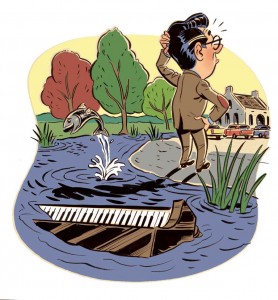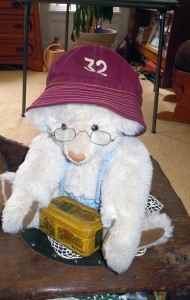Lauding the liberal arts
It was a pleasure to read Julia Queller’s insightful and engaging article in the winter Scene about why she has chosen to major in religious studies (“Questions a religion major gets asked”). At a time when many seem to regard a college education as little more than a stepping stone to financial security and question the value of a liberal arts degree, it was refreshing and encouraging to hear that some students still see college as primarily an opportunity to pursue their intellectual interests and develop a deeper understanding of the world and human culture. I am also sure that after Ms. Queller graduates she will find many professional opportunities available to her, other than becoming a rabbi.
Jeff Cook ’67
Cresskill, N.J.
Asking for an update
I read Dean Suzy Nelson’s piece in the winter Colgate Scene (“A message from Dean of the College Suzy Nelson”) with interest at first because she was going to touch on racism and sexual assault on campus. However, as I went through it, I was unhappy that she did not give much attention to what’s being done to deal with racism on campus. Even if discussions remain work in progress, it’s still important to know that they’re even happening at all. I was left with an impression that little has been done since all the discussions between students and the administration back in 2014. The campus has been dealing with sexual assaults for years (heck, my own major adviser was on the committee when I was there 2005–2008). I’d like to see Dean Nelson address the “other” story in the next Scene.
Sara Halpern ’08
Columbus, Ohio
Identifying the problem
If ever one of the Scenes had a theme, it was your winter 2016 edition. From front cover to back — and most especially Suzy Nelson’s message — your staff made certain the opener was the close. You made it quite clear that women students at Colgate are everything from “vulnerable” to “bystanders” to “protesting” sexual climate to being under “sexual assault.” A Hamilton winter may have sent the courageous and glorified protesters indoors, but the resonant theme does just that — resonates. Armed with the New York State legal definition of sexual assault and responsibility for “positive consent,” your far-too-many assistant deans and assistant provosts and adjunct professors in charge of everything from Title IX adherence to inclusivity should have very little trouble making the females on the Hill less uncomfortable. More to the point, though, is identifying the real problem in all of this “climate.”
The great unsaid here — at least as far as your staff goes — is the negative climate created by the men students at Colgate. If I further add the “racial justice” element, then that field is reduced to white men students at Colgate. Nowhere do I read that that particular slice of the community is your starting point, let alone your problem. With young women standing alone on a stage, groups of young women protesting outside campus centers catering to them, and with young women coalescing to even come to grips with their own sexual proclivities, it would seem to me that one of the “tools” a Colgate female undergraduate can pull from her belt in order to navigate the “road map” is to seek the truth by starting at the beginning. What’s the beginning? Articulating the question.
I submit that the Scene did not have the courage to identify and articulate the question. That lack of integrity is more than lack of academic rigor; it is dishonest. There is something more that Colgate faculty and staff can do to ensure that rape does emphatically not happen before these young women undergraduates become graduates. Your community can ensure the “public community” does not repeat the Duke University venom and rush to judgment of 2006. Finally, the Colgate “prevention and support services” can make the real-world point that single women must not cry “rape” and married women must not cry “divorce” so as to get the perpetual paycheck that the grossly irresponsible State of New York itself regularly doles out.
In the meantime, if this is your “scene,” I’ll make sure my grandchildren don’t make it.
Todd A. Clemens ’77
Scottsdale, Ariz.
Still more folklore
Loved the article (“Colgate Folklore, Facts & Falsehoods,” autumn 2015)! Here’s some Colgate folklore I remember from my days in the fair Chenango Valley:
- The New Yorker cartoonist Charles Addams, who attended Colgate for two years in the late 1920s, was inspired to create his “Addams Family” cartoons after boarding with an eccentric family who lived in an old Victorian house on Maple Avenue.
- While working the night shift at the Colgate observatory, two students sighted a mysterious heavenly body that wasn’t on any of their astronomical charts. Convinced that they might have discovered a new planet, and unable to contain their excitement, they woke up their physics professor from a deep sleep. The professor dutifully threw a coat over his pajamas and drove to the observatory, where, peering through the telescope, he determined that the new planet was in fact the “o” in the red neon Grand Union supermarket sign.
- After taking a campus tour during the early 1970s, famed CBS anchorman Walter Cronkite was rumored to have said: “There are two places I would never allow my daughter to visit: the DMZ in Vietnam and Colgate during spring party weekend.” (In some versions, it was — oddly enough — President Lyndon Johnson who said this.)
- This last anecdote I heard from the great Professor Douglas “Doc” Reading. The college All-American and pro football hall of fame running back Jim Brown wanted very badly to attend Colgate in the 1950s, but was unable to meet the stringent academic requirements, so went to Syracuse instead. The Doc was painfully reminded of this fact every time he saw Brown charging down the lacrosse field (he was an All-American in this sport as well), trampling over the half-dozen Colgate players who were desperately trying to stop him.
Speaking of The Doc, there were many, many legends surrounding his tenure at Colgate, but alas — they’re just a wee bit too “salty” to repeat here.
Kelly Yoho ’82
Rochester, N.Y.

On “Folklore, Facts & Falsehoods”: Thanks for this enlightening and amusing article! As to what has gone into and been pulled from Taylor Lake, let me add another auto: a 1968 Plymouth Fury III (I believe) … a car that was figuratively, and in this case literally, a boat! It was senior week 1977, and a bunch of my fraternity brothers convinced one of us to drive his car into (temptingly close) Taylor Lake. Several piled in, took it a short way on Broad Street, turned off on a footpath, then turned off the footpath and sped headfirst into the lake! Thankfully, it wasn’t deep and all made it out safely, but it wasn’t long before there was a call from a dean (Fred Dobens, I believe) telling the car owner and his buddies to get the car out of the lake if they wanted to graduate. Apparently, they did, since all managed to graduate and proceed to illustrious careers in the law, national defense, and business. Go, ’gate!
Ladd Connell ’77
Arlington, Va.
Colgate pride
My father (Donald D. Hodges) was in the Class of ’32. I am attaching a photo of his beanie on a beloved bear. He was always proud to have gone to Colgate. Although he is deceased, we have treasured many of his memories.

We had not ever heard of the green beanies, though (“Colgate Folklore, Facts & Falsehoods,” autumn 2015). He was a leader in the orchestra band, playing the drums, as has one grandson and one great-grandson.
Thank you for the stories. We sure enjoy the format of the Scene.
William E. Hodges
Sherburne, N.Y.






